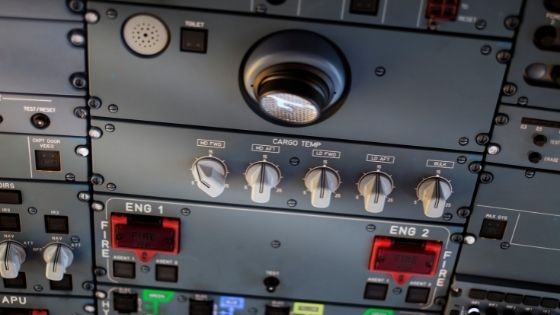Aircraft switches are used in every other system of modern aircraft, including flight control systems. They are employed in fuel, lubrication, propulsive, and water systems and can be further integrated into systems that aid in keeping the cabin at a comfortable temperature and pressure. Aircraft switches are further connected to a wide range of sensors and transducers. This array of components manages a wide range of proactive systems, including hydraulic systems for braking, linear and rotating control surfaces, and processes that control the lowering and raising of the landing gear. In modern commercial aircraft, these switches are often used to relay instruction back and forth to assist pilots in a wide range of functions. According to Fortune Business Insights, the global aircraft switches size was valued at USD 2.01 billion in 2021 and is expected to reach a valuation of USD 2.60 billion by 2028 at a CAGR of 3.71% over the forecast period.
Lockdowns & Shutdown of Aircraft Manufacturers Slowed Down Growth During Pandemic
- Nationwide lockdowns during the ongoing pandemic in major aviation-based countries, such as India, France, China, and the U.S., led to a highly declining market rate as demand for aircraft and aircraft components dissipated.
- An overall delay in manufacturing and production coupled with the faltering transportation sector further impacted the sector of aircraft switches in a negative manner.
- The pandemic forced the dominant players to operate at less-than-optimal capacity. Manufacturing units reported that by May 2020, only around 75% of the employees were available to work in shift-based rotations.
Increasing Adoption of Fly-by-Wire Systems in Aircraft
TE Connectivity announced that it registered 10% less revenue in 2020 compared to 2019, owing to the pandemic. The company registered net sales of USD 12.2 billion for the fiscal year 2020. Limitations on international, regional, and even local travel further reduced the demand for air travel, triggering a decline in the volume of aircraft switches.
Factors, such as increased demand for lightweight aircraft, led to rising demand for fly-by-fly systems within aircraft. Fly-by-wire systems transmit electrical signals to flight control actuators with the aid of electrical switches. This demand is expected to encapsulate the demand for aircraft switches.
BAE Systems PLC announced that it was granted a contract by Aerion Supersonic for designing and developing a fly-by-wire system for Aerion’s AS2 supersonic business jets. This integration will include active inceptors, remote-control units, actuator based units, and flight control computers.
North America Occupied Dominant Share Globally due to the Presence of Key Players
North America occupied the largest global share with an estimated value of USD 0.53 billion in 2020. The immense growth is accredited to the presence of key manufacturers of aircraft and aircraft component manufacturers such as GE Aviation, the Boeing Company, Lockheed Martin Corporation, and Raytheon Technologies Corporation. Additional players in aircraft switches, such as Honeywell International Inc., Curtiss-Wright Corporation, and Collins Aerospace, will further expand their presence in the region.
Airbus SAS announced launching an Advanced Superconducting and Cryogenic Experimental Powertrain Demonstrator (ASCEND) for studying the impact of cryogenic temperatures and superconducting materials on the total efficiency of electrical propulsion systems within switches in aircraft.
Fortune Business Insights lists the Key Players
TE Connectivity, Eaton Corporation, ITT Inc., Curtiss-Wright Corporation, Meggitt PLC, Unison PLC, Honeywell International Inc., Collins Aerospace, Applied Avionics Inc., and Safran are the key players. A majority of these players approach the sector of aircraft switches by expanding their global presence by launching novel products and investing heavily in R&D.
Replacing Conventional Switches with LED Pushbuttons will Increase Market Volume
The latest generation of military and commercial aircraft has integrated Human-Machine Interface (HMI) within their design specs. HMIs are highly capable of decreasing a pilot’s work, which enhances productivity. Additionally, the digitalization of the aircraft sector led to an increased demand for upgrading conventional switch technology, further triggering an upscale in product sales. An ongoing trend of LED-based push-button switches in the cockpit will further increase the product demand. Digital data bus interfaces push the demand for low-profile LED push-button switches.
Aerospace Optics Inc. launched lighted push-button switches with its ARINC 429, which possess a discrete conversion capability. These switches offer a rapid information exchange between analogue and digital interfaces. The growing demand for automation & digitization in aircraft will push the boundaries of the market.
Future of Aircraft Switches
Replacement of conventional seatback screens with the limited modality of entertainment content with a personalized model increased the demand for In-Flight Entertainment & Communication (IFEC). Technological advances in seat designs coupled with real-time data and connectivity measures further surged the demand for IFEC. In July 2020, Panasonic Avionics Corporation received a contract from Air Liban for supplying entertainment and connectivity solutions for 15 Airbus A321 aircraft.
Furthermore, a report by the International Air Transport Association (IATA) stated that passengers traveling by air will increase twice to 8.2 billion by 2037. An increasing number of tech-savvy passengers will further push the expanding nature of aircraft switches. The rising number of next-generation aircraft procurement coupled with an increasing number of air commuters will contribute to the market growth.













